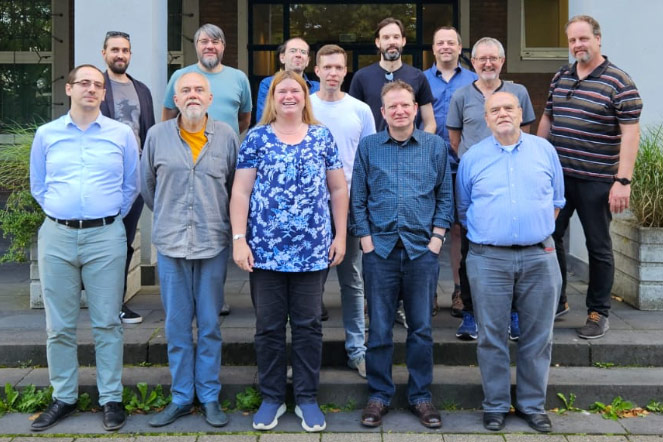Technical Meeting at RWTH Aachen, July 2025
Over two highly productive days, leading cheminformatics researchers, developers, and practitioners came together at RWTH Aachen University to drive forward the evolution of the IUPAC International Chemical Identifier (InChI). The focus was ambitious: tackling complex stereochemical representation in inorganics and polymers, exploring enhancements for atropisomerism, refining file format requirements, and charting a clear roadmap for upcoming InChI releases and governance.
Revisiting Stereochemistry in Molecular Inorganics
One of the core themes of the meeting was the challenge of capturing stereochemistry in molecular inorganics, particularly in coordination complexes with non-trivial geometries. Gerd Blanke, Thomas Dörner, Ulrich Schatzschneider and Andrey Yerin guided the discussions, which revolved around the conceptual and practical demands of defining stereochemistry beyond tetrahedral and planar centers.
A key proposal involved the introduction of a new /x layer dedicated to inorganic stereochemistry representing the polyhedral environments such as octahedral, trigonal bipyramidal, and square pyramidal geometries. The group agreed that the canonicalized atom numbering forms the basis for this layer. Importantly, stereochemical information will only be computed if it is explicitly defined, either via wedged/dashed bonds or through 3D coordinates. The geometries of pseudo 3D depictions which are 2D representations of the structure(!) will be ignored. This is a necessary constraint to maintain consistency with organic InChI layers.
The concept of using “multicenter atoms” rather than the ambiguous “*-atom” also gained support, especially in the context of haptic and polyhapto bonding.
Trust the Drawing: On Atropisomers and Input Authority
Another major area of focus was the representation of atropisomerism, which has long presented challenges due to its dependence on conformational stability and its ambiguous depiction in 2D diagrams. The group converged on a guiding principle: the InChI should reflect what is drawn. If stereochemical elements such as atropisomerism are indicated through wedge bonds or reliable 3D geometry, they should be encoded. If not, they should be omitted.
This “trust the input” approach recognizes the impossibility of algorithmically determining atropisomerism in all cases without introducing inconsistency or overinterpretation. Atropisomers will be described using the model proposed by Andrey Yerin. Where no stereochemical markers are present, InChI will not attempt to guess, just as undefined stereocenters are currently ignored.
Polymer-InChI: From Vision to Prioritization
The second day of the meeting turned attention to polymers, which represent some of the most structurally ambiguous (and industrially relevant) chemical materials. Thomas Exner and Gerd Blanke presented recent progress in Polymer-InChI development, including support for structural repeating units (SRUs), copolymers and wildcard atoms (* atoms).
While enthusiasm for Polymer-InChI was high, the group reached consensus that polymers cannot yet be fully incorporated into the “standard” InChI without stronger guarantees of structural uniqueness. Instead, development will continue with a focus on product-based representations, not synthetic recipes. The ability to describe what is known – especially for random or undefined polymers – was seen as crucial for real-world use cases like surfactants and industrial mixtures.
The meeting emphasized the need to distinguish clearly between polymer-like molecules (with defined atomistic precision) and more abstract materials. Examples such as “Tween 80” and COFs highlighted the complexity of creating universal representations for such systems. The group agreed to move forward with clearer definitions and example sets, and to continue refining the /z layer for polymer-related information.
InChI Development Philosophy: Progress Over Perfection
Throughout the meeting, participants frequently returned to a central tension in scientific infrastructure development: when is a model “good enough” to be released? Jonathan Goodman summarized it well: delaying for a perfect 99% solution may be less useful than deploying a robust 90% solution and building iteratively from there. The group strongly endorsed a stepwise approach: stereo encoding for inorganics will be introduced gradually, beginning with clear-cut polyhedral systems and expanding to more complex scenarios later.
Governance, Implementation, and Communication
Ian Bruno provided an overview of InChI governance developments, including the formation of new working groups and a draft sign-off checklist that will guide future releases. Participants discussed the importance of balancing academic and industrial use cases and ensuring that contributors across chemical domains (organic, inorganic, nano etc.) have a voice.
The group also addressed versioning and roadmap planning. It has been proposed to label the upcoming release v1.50. Beside addressing the bond handling of the molecular inorganics the release will include better testing infrastructure and documentation as well. The next full release (enhanced bond handling and stereochemistry) will follow once stereochemistry in molecular inorganics has been thoroughly validated.
Tools, APIs, and Reference Data
The technical side of the meeting included discussions around toolchains and implementation strategies. The developers agreed on the value of making the InChI Web Demo API-accessible, and plans are underway to establish a reference test set for molecular inorganics – featuring examples like cis- and trans-platinum complexes.
The need for better file format compatibility also emerged. The molfile remains the current standard input, but it lacks some representation functionality like block bonds (e.g. used in sugar representations) that are missed in InChI desired. Discussions continue around the potential of a dedicated InChI file format, although adoption concerns remain. The extension of the InChI API was discussed as an alternative approach.

Looking Ahead
The meeting concluded with a shared sense of momentum and direction. The participants agreed that the next online technical session will take place in mid-September 2025 to refine the /x and /z layers further, discuss examples, and advance governance structures. InChI is entering a new chapter and becoming more inclusive of real-world complexity and better equipped for advanced chemistry communication.
This work would not be possible without the continued support of the InChI Trust, VolkswagenStiftung, NFDI4Chem, the BMFTR (DALIA project), and the Beilstein-Institute.
We extend our sincere thanks to all contributors – those in the room and online – for their expertise, candor, and collaborative spirit. Special appreciation goes to the developer team: Djordje Baljozovic, Nauman Ullah Khan, Jan Brammer, Felix Bänsch, Jan Holst Jensen, and to Frank Lange for the InChI Web Demo infrastructure.
Want to explore more?
Web Demo: https://iupac-inchi.github.io/InChI-Web-Demo/